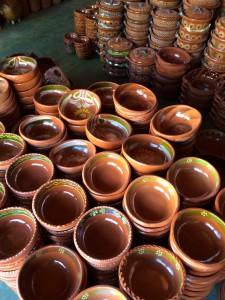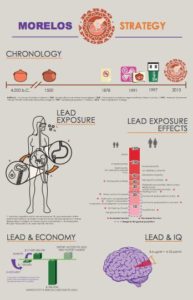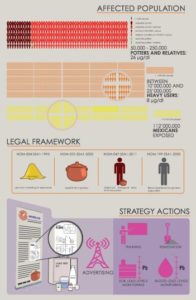
Up to 20% of Mexicans have elevated blood level levels. This is from the use of traditional Mexican pottery—the colorful plates, pots and other wares that you see in almost every home and restaurant in the country. Traditional Mexican pottery has been produced by local artisans over the past five centuries using leaded glazes.
It is a national health problem rooted in a 500-year-old tradition that has, so far, been hard to break.
Since 2008, Pure Earth has been working with local authorities in Mexico to address the issue of lead in pottery. Pure Earth’s Barro Aprobado project (Spanish website) is working to raise public awareness about the dangers of leaded pottery, and to promote the use and production of lead-free pottery. The project is focused on Morelos state with plans to expand on its success nationwide.
- listen to audio of the press conference from Mexico , Thursday, June 26.
- Visit the Spanish Language website: http://barroaprobado.org/
FACT SHEET: MEXICO’S 500-YEAR-OLD PROBLEM
- Number of traditional leaded pottery workshops: an estimated 10,000 to 50,0000
- Number of people working in these traditional workshops: an estimated 50,000 to 250,000, including children.
- CDC blood lead level of concern: 5 ug/dl
- Average blood levels in the U.S.: 1.8 ug/dl
- Average blood lead levels in Mexico City: about 8 ug/dl (levels are expected to be much higher in rural areas, where traditional pottery is used more often than in the wealthier cities)
- Average blood lead levels in Mexico: about 10 ug/dl
- Average blood lead levels for children and their families who work in or live near traditional pottery workshops: 26 to 40 ug/dl
- Amount of traditional pottery produced each month: 3,500 tons
- Amount of lead oxide used in pottery each month: 350 tons
- Amount of lead oxide in traditional leaded glaze (Greta): 85%
- Number of lead-free pottery workshops: 100 (as of 2013)
IMPACT OF LEAD POISONING
Lead is a potent neurotoxin, causing lower intellectual capacity, neurological damage, and cardiovascular disease, amongst other problems. The presence of lead in children lowers I.Q. by an estimated 4-7 points for each increase of 10 μg/dL. (Get more facts about toxic lead)
LEAD POISONING IN MEXICO
Calculations show that the impact of lead poisoning in Mexico could be greater than any other environmental factor, including water sanitation and hygiene, diarrhea, respiratory infections, and injuries. As lead has been completely phased out of gasoline since 1997, leaded pottery is now the main source of lead exposure in the country.
A 2014 peer reviewed paper (published in the Annals of Global Health by Pure Earth, the National Institute of Public Health in Mexico (INSP), The City University of New York and Columbia University) concluded that although blood lead levels (BLLs) have decreased significantly in Mexico over the past 35 years, they remain significantly elevated. In urban areas, the post-leaded gasoline average blood lead level in Mexico is still more than 4.5 times higher than the average found in the United States (5.52 and 1.2 ug/dL, respectively).
Researchers conducting the study estimated that this would result in 820,000 disability adjusted life years (DALYs), with an average lead-induced I.Q. decrement of 5 points in Mexican children aged 0 to 4 living in urban areas. In rural areas, where robust data was not available, the resulting health effects are expected to be much worse. These results indicate that nearly half of Mexican children have a blood lead level that is above the threshold where intelligence and behavior is affected. In comparison, only 2.5% of children in the United States hit this threshold.
In 2015, Pure Earth worked with the Ministry of Health in Morelos to screen 304 newborns for lead poisoning, and to identify the source of that poisoning. Our studies revealed that the lead poisoning was attributed solely to lead-glazed pottery used by the baby’s family to cook and serve their meals, everyday. Those children identified with high blood lead levels are now receiving the appropriate medical treatment. The results of the health screenings have been shared with the government and will be published shortly.
THE SOLUTION
Lead-free glaze. A lead-free glaze was developed in Mexico with governmental support, with boron as a substitute. The process is similar in function and creates a similar aesthetic compared to traditional leaded glazes. This means that the lead-free glaze works in existing kilns, and produces the same quality pottery. It is also half the cost of leaded glaze.
THE PROBLEM
Breaking tradition and a lack of awareness.
- Artisans are reluctant to switch to the lead-free glaze partly because of tradition, and partly because of a lack of understanding about the problem and risks of leaded glazes.
- For consumers, there is no way to tell if the pottery they are using or buying is lead-free unless they do a lead test. There is no certification system for lead-free pottery or any labeling. Currently, most traditional pottery produced and sold is made with leaded glaze.
Learn more:
- Barro Aprobado
- Why are millions of children in Mexico still suffering?
- Fact Sheet: What is the #1 Childhood Environmental Health Threat Globally?
- Photo Essay: Mexico – Lead Exposure From Traditional Pottery
- Dinner Served On 960 Pieces Of Lead-Free Pottery Sends Urgent Message Across Mexico
- Want lead-free food? Visit the first “Barro Aprobado” restaurant in Mexico
- Homero Aridjis’ Heartfelt Plea For A Lead-Free Mexico





